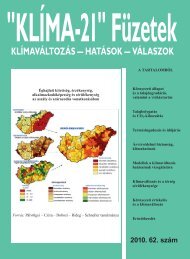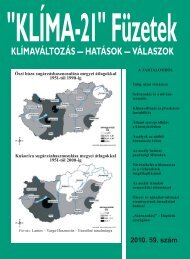KLÃMA-21 Füzetek 61. szám - VAHAVA Hálózat
KLÃMA-21 Füzetek 61. szám - VAHAVA Hálózat
KLÃMA-21 Füzetek 61. szám - VAHAVA Hálózat
Create successful ePaper yourself
Turn your PDF publications into a flip-book with our unique Google optimized e-Paper software.
PUKY: A klímaváltozás és a kétéltűek 119<br />
Global Change Biology. 12 (6): 1069–1078. pp. (10) CORN, P. S. (2005): Climate change and<br />
amphibians. Animal Biodiversity and Conservation. 28(1): 59–67. pp. (11) CORN, P. S. – FO-<br />
GELMAN, J. C. (1984): Extinction of montane populations of northern leopard frog (Rana pipiens)<br />
in Colorado. Journal of Herpetology. 18: 147-153. pp. (12) CROWLEY, T. J. (2000): Causes<br />
of climate change over the past 1000 years. Science. 289: 270-277. pp. (13) CRUMP, M. L. –<br />
HENSLEY, F. R. – CLARK, K. L. (1992): Apparent decline of the golden toad: underground or<br />
extinct. Copeia. 1992: 413-420. pp. (14) DAVIDSON, C. – SHAFFER, H. B. – JENNINGS, M. R.<br />
(2002): Spatial tests of the pesticide drift, habitat destruction, UV-B and climate change hypotheses<br />
for California amphibian declines. Conservation Biology. 16: 1588-1601. pp. (15)<br />
DONELLY, M. A. – CRUMP, M. L. (1998): Potential effects of climate change on two neotropical<br />
amphibian assemblages. Climatic Change. 39: 541-5<strong>61.</strong> pp. (16) GIBBS, J. P. – BREISCH, A. R.<br />
(2001): Climate warming and calling phenology of frogs near Ithaca, New York, 1990-99.<br />
Conservation Biology. 15: 1175-1178. pp. (17) GIBBS, J. P. – KARRAKER, N. R. (2006): Effects<br />
of warming conditions in Eastern North American forests on redback salamander morphology.<br />
Conservation Biology. 20(3): 913-917. pp. (18) GROSSENBACHER, K. (1995): Observations<br />
from long-term population studies in Switzerland. Froglog. 15: 3-4. pp. (19) GYOVAI F. (1989):<br />
Demographic analysis of the moor frog (Rana arvalis Wolterstorffi Fejérváry 1919) population<br />
in Fraxino pannonicae – Alnetum of the Tisza basin. Tiscia. XXIV: 107-119. pp. (20)<br />
HEYER, W. R. – RAND, A. S. – GONCALVEZ DA CRUZ, C. A. – PEIXOTO, O. L. (1988): Decimations,<br />
extinctions, and colonizations of frog populations in southeast Brazil and their evolutionary<br />
implications. Biotropica. 20: 230-235. pp. (<strong>21</strong>) HOULAHAN, J. E. – FINDLAY, C. S. – SCHMIDT, B.<br />
R. – MEYER, A. H. (2000): Quantitative evidence for global amphibian population declines.<br />
Nature. 404: 752–755. pp. (22) ILOSVAY GY. (1977): Effect of urbanization on the herpetofauna<br />
of a settlement at the Tisza (Szeged). Tiscia. XII: 123-130. pp. (23) JONES, P. D. – OSBORN, T. J.<br />
– BRIFFA, K. R. (2001): The evolution of climate over the last millennium. Science. 292:<br />
662-667. pp. (24) KÉRI A. (2002): A természetvédelmi mentőakciók és szerepük a környezeti<br />
nevelésben. In: Schróth Á. (szerk.): Válogatás a középiskolai „Környezeti nevelés” területeiből<br />
– Tanulmányok Magyarország és az Európai Unió természetvédelméről. TEMPUS Institutional<br />
Building Joint European Project. Trefort Kiadó, Budapest. 151-174. pp. (25) LAURAN-<br />
CE, W. F. – MCDONALD, K. R. – SPEARE, R. (1996): Epidemic disease and the catastrophic<br />
decline of Australian rain forest frogs. Conservation Biology. 10: 406-413. pp. (26) MARGOLIS,<br />
M. – WHIPP, L. – BRUNING, K. – DE FREITAS, F. (2006): Frogs: Global Warming’s First Victims.<br />
Climate change is no longer merely a matter of numbers from a computer model. With startling<br />
swiftness, it is reordering the natural world. Newsweek International Edition. 2006. október<br />
16. (27) MEYER, A. H. – SCHMIDT, B. R. – GROSSENBACHER, K. (1998): Analysis of three<br />
amphibian populations with quarter-century long time-series. Proceedings of the Royal Society,<br />
London B. 265: 523-528. pp. (28) OSBORNE, W. S. (1989): Distibution, relative abundance<br />
and conservation status of Corroboree frogs, Pseudophryne corroboree Moore (Anura:<br />
Myobatrachidae). Australian Wildlife Research. 16: 537-547. pp. (29) POUNDS, J. A. – CRUMP,<br />
M. L. (1994): Amphibian declines and climate disturbance: the case of the golden toad and the<br />
harlequin frog. Conservation Biology. 8: 72-85. pp. (30) POUNDS, J. A. – FOGDEN, M. P. L. –<br />
CAMPBELL, J. H. (1999): Biological response to climate change on a tropical mountain. Nature<br />
398: 611-615. pp. (31) PUKY M. (2000): A comprehensive three-year herpetological survey in<br />
the Gemenc Region of the Danube – Dráva National Park, Hungary. Opuscula Zoologica.<br />
XXXII: 113-128. pp. (32) PUKY M. – SCHÁD P. – SZÖVÉNYI G. (2005): Magyarország herpetológiai<br />
atlasza/Herpetological atlas of Hungary. Varangy Akciócsoport Egyesület, Budapest.<br />
207. p. (33) READING, C. J. (1998): The effect of winter temperature on the timing of breedign<br />
activity in the common toad Bufo bufo. Oecologia. 117: 469-475. pp. (34) READING, C. J.






